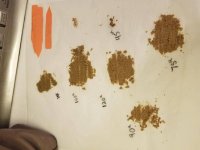You are using an out of date browser. It may not display this or other websites correctly.
You should upgrade or use an alternative browser.
You should upgrade or use an alternative browser.
NEW Colorado Growers Thread
- Thread starter Avinash.miles
- Start date
M
meowmeowmeow
Miles I can neither confirm or deny, but I may of heard talk around the water cooler about that. 
NBK I feel in love with the flower and had to run her. Started with 2 cuts. The Male which I should grew had 3 big toe sloth indica leaves. The terpene present ehatever it is I get in Deathstar, 4 corners, some afgjani s and a few other strains not specific to either I or S ... that garbage funk with a rotting tomatoe soup or the fresh Campbell's tomato soup smell. All good.

NBK I feel in love with the flower and had to run her. Started with 2 cuts. The Male which I should grew had 3 big toe sloth indica leaves. The terpene present ehatever it is I get in Deathstar, 4 corners, some afgjani s and a few other strains not specific to either I or S ... that garbage funk with a rotting tomatoe soup or the fresh Campbell's tomato soup smell. All good.
been hoping to find some boletes and chantrelles.... no luck
Just joined the club,just moved to the high rockies, and have to say, I'm kinda dissatisfied with the shops, good stuff I guess, but can't wait to get my own started up again...seems the variety was much better years ago when it first started...plenty of potent flavourless indica to be had now, I visited the first year it became legal, seemed better then.
I gotta hurry up and get my Sativa's going
I gotta hurry up and get my Sativa's going
been hoping to find some boletes and chantrelles.... no luck
The boletes should be starting soon, at lower elevations, and they work their way up to higher elevations as the summer turns to fall. I think I remember reading that their fruiting period is triggered by nighttime temperatures dropping.
I'm a big fan of Boletus Edulis. If you can't find any in Colorado, I know lots of great spots just across the border in Wyoming. I hunted there for decades before I moved down to Denver.
I need to get some time in scouting for some new collecting areas down here. Lemme know if you want some company on a bolete hunt!
M
meowmeowmeow
Just joined the club,just moved to the high rockies, and have to say, I'm kinda dissatisfied with the shops, good stuff I guess, but can't wait to get my own started up again...seems the variety was much better years ago when it first started...plenty of potent flavourless indica to be had now, I visited the first year it became legal, seemed better then.
I gotta hurry up and get my Sativa's going
Homegrown is where its at for sure.
Commercialy grown decent sativas are rare due to the market, longer flowering time and potential higher price point.
Rec and Med flower share similarities in quality in CO. I've had acceptable flower from both sides.
Variety has started to penetrate the market sue to METRC allowing new strains to be entered easier.
Over the past 2 years I have seen the quality trend upwards again but pails in comparison to my experience here 5 yrs ago.
Maybe you guys would know.
Was wondering about clubs and such where the local bud heads meet and greet.
Does anyone in CO do seed trades? I got a good amount of Malawi x Caribe seeds I'd like to trade or even gift...potent Sativa,,,lol its what I've been smoking before I came to co., blows the commercial indica's here out the door.not even close.
Was wondering about clubs and such where the local bud heads meet and greet.
Does anyone in CO do seed trades? I got a good amount of Malawi x Caribe seeds I'd like to trade or even gift...potent Sativa,,,lol its what I've been smoking before I came to co., blows the commercial indica's here out the door.not even close.
Maybe you guys would know.
Was wondering about clubs and such where the local bud heads meet and greet.
Does anyone in CO do seed trades? I got a good amount of Malawi x Caribe seeds I'd like to trade or even gift...potent Sativa,,,lol its what I've been smoking before I came to co., blows the commercial indica's here out the door.not even close.
DEF all kinds of peeps throw lil get togethers....
bongathon was last weekend, i ve been meaning to post pics
reggae show in hotchkiss coming up w 420 camping and vibes, sept 8th
M
meowmeowmeow
Maybe you guys would know.
Was wondering about clubs and such where the local bud heads meet and greet.
Does anyone in CO do seed trades? I got a good amount of Malawi x Caribe seeds I'd like to trade or even gift...potent Sativa,,,lol its what I've been smoking before I came to co., blows the commercial indica's here out the door.not even close.
Does a bear shit in the woods?
Like Avi said there are many events.
Comparing a sativa to commercial indica is confusing to me? If its that good why lower down to commercial CO trash. Even bettsr if its got a shorter flower time.
Does a bear shit in the woods?
Like Avi said there are many events.
Comparing a sativa to commercial indica is confusing to me? If its that good why lower down to commercial CO trash. Even bettsr if its got a shorter flower time.
Its a pretty long flowering sativa, high yielding though...works great 12/12 from seed...ideally is 12/12 from seed directly in like a 5 gallon bucket.almost like you would run autos...grows one massive cola 100-120 days from seed.
M
meowmeowmeow
Any of you catch this Denver post story. With in the month before this story was published, they where talking about how hundred of court cases had been sealed.
If any of you recall when the state suspended 4 Doctors for writing high plant counts, then the Doctors filled a lawsuit against the state. Many of use where fallowing it then there was nothing, no news about the case at all...
This tells why and what/why...........!
https://www.denverpost.com/2018/08/05/colorado-policing-marijuana-doctors-shrouded-justice/
If any of you recall when the state suspended 4 Doctors for writing high plant counts, then the Doctors filled a lawsuit against the state. Many of use where fallowing it then there was nothing, no news about the case at all...
This tells why and what/why...........!
https://www.denverpost.com/2018/08/05/colorado-policing-marijuana-doctors-shrouded-justice/
green404
Member
This tells why and what/why...........!
Can't Read it.
The Denver Post is making people pay $.99 to read an article now.
Douglas.Curtis
Autistic Diplomat in Training
They didn't charge me .99, since I don't usually read it.  Here it is, for those who are unable to get it for free.
Here it is, for those who are unable to get it for free.
Denver Post said:By David Migoya | [email protected] | The Denver Post
PUBLISHED: August 5, 2018 at 6:00 am | UPDATED: August 5, 2018 at 8:21 pm
Sign up for newsletters and alerts
Submit your news tips or photos
Most Popular
- Two Frederick girls may have been strangled to death, defense motion suggests
- Bodies of two Frederick girls found inside oil and gas tanks, sources say
- Frederick man suspected of killing wife, two young daughters had climbed from deep financial troubles to apparent prosperity
- “This is Colorado”: More than 100 gather at emotional remembrance of slain Frederick mother and two daughters
- Flood waters run onto I-25 near Colorado Springs as severe thunderstorms slam Front Range
- Guest Commentary: States like Colorado should embrace sports betting for a public good
A lawsuit that accused Colorado regulators of quietly and illegally concocting a policy to police doctors who recommend medical marijuana to patients was entirely hidden from public view during a nearly three-year court battle, secreted behind a judge’s order to keep it that way, The Denver Post has found.
Nine physicians filed the lawsuit in Denver District Court in March 2015 against the Colorado Department of Public Health and Environment, which regulates and maintains the state’s medical marijuana registry, and the Colorado Medical Board, which regulates doctors. A judge initially agreed with the doctors’ assertion that the policy was created illegally, but an appeals court overturned that decision late last month.
“There is no justification for concealing the entire file of a case with such a high-degree of public interest,” said Frank LoMonte, director of The Brechner Center for Freedom of Information at the University of Florida. “This is more egregious because you have a case that implicates the behavior of a government agency.”
The lawsuit is just one of thousands, including felony criminal cases, that a Denver Post investigation found were hidden from the public, some of them for years and all the result of judges’ orders that are also suppressed.
The doctors, each listed only as a John Doe because the judge gave them anonymity protection, challenged the process the state used to create the policy, saying it was secretive and lacked public input or public hearings, a violation of Colorado’s open meetings laws. As such, they argued, any referral to the Medical Board was illegitimate, as well as any subsequent investigation.
Denver District Judge Jay Grant’s decision in October 2016 found that CDPHE had violated open-meetings laws. He ordered the agency to stop relying on the rule to refer doctors to the Medical Board for investigation, but allowed the board to continue its investigations anyway.
The policy adopted in 2014 laid out three criteria that could cause the health department to refer a doctor to the Medical Board for investigation:
The policy was the result of a 2013 state audit that found CDPHE, the state’s gatekeeper to medical marijuana, had lax regulation of physicians and a general failure in overseeing caregivers.
- Recommending patients grow more than 24 marijuana plants (contrary to state law that limits it to six) without substantiating a medical necessity;
- Having a patient list in which one-third or more of their clients are under the age of 30;
- Having a patient caseload higher than 3,251.
“This policy was adopted and implemented without providing public notice and during which no minutes from meetings were taken,” Grant wrote. “Furthermore, the formulation of this policy does not appear to be based on any scientific or medical evidence.”
Grant’s decision was also suppressed, according to the state’s database of court cases.
The Colorado Court of Appeals on July 26 ruled the state broke no laws and the policy was created properly. Lawyers for the doctors said they would appeal.
Hidden from the outset
Although the court battle continues over whether the agencies had operated in secrecy in adopting the policy, The Post found that the legal process that evaluated the alleged activity was hidden.
From the day the lawsuit was filed and throughout the nearly three years the case was litigated in district court — a process that included depositions from government employees and officials, as well as evidence of how the policy was kept secret — the details of the government’s alleged misconduct remained suppressed from the public.
That meant no trace of the case appeared on any courthouse database where the public can track lawsuits filed in Colorado, nor on the state-recommended services that require a fee. There was no complaint to review; there were no court records available of any kind.
It was as if it didn’t exist at all.
Related Articles
Although courtrooms are open even for a suppressed case, the only way to know when a hearing is to be held is to be in court when it was scheduled. But that wouldn’t have mattered in the John Does lawsuit, The Post found, because only two hearings happened in all the years the case was pending — and one of those was a teleconference not ordinarily open to the public.
- Shrouded justice: Thousands of Colorado court cases hidden from public view on judges’ orders
- Editorial: “Shrouded justice” uncovers court secrecy in need of reform
- How a Denver Post reporter found that thousands of Colorado court cases have been hidden from public view
- How news coverage of two high-profile sex-crime cases faded after they were suppressed by Colorado judges
The doctors’ attorney, Carmen Decker, said even though the doctors were already identified only as John Doe #1, John Doe #2, and so on, she asked for the suppression order because she feared other court documents might unintentionally show the doctors’ real names.
Neither Denver District Judge Morris Hoffman, who granted the suppression request, nor Grant responded to Denver Post emails regarding the suppression.
LoMonte said granting the doctors anonymity is not a good reason to suppress the entire case.
“This is about the integrity of a government rule-making process and the attorney general should have spoken up for that interest of the public, but the judge should have done it on their own.”
According to Decker, Colorado Attorney General Cynthia Coffman’s office, which defended the state agencies, never objected to the suppression. A spokeswoman for Coffman said she had no comment.
The Post acquired copies of the judges’ orders because they were inadvertently included in the appellate records of other lawsuits in which other doctors have challenged the same secret rules and the subsequent Medical Board investigations against them. Those cases were not suppressed.
The appeals in the John Does case are also not suppressed.
The Post has been able to identify eight of the nine anonymous doctors because lawsuits the Medical Board separately filed to enforce investigation subpoenas against them, though also suppressed, are now included in the state’s court-records databases and referred to by their case numbers in appellate documents.
The doctors are still practicing and the state’s investigations have been put on hold pending the outcome of the case and its appeals.
No suppressed case — not the names of the parties or the outcome — was available on the state’s public computer databases until The Post began investigating the practice several months ago. Since then, the state has included the case numbers and the names of those involved among electronic courthouse records, though the documents behind them, such as the complaint detailing allegations in a lawsuit, remain protected.
In its investigation, The Post found that more than 6,000 civil and criminal cases have been suppressed from the public since 2013. Of those, more than 3,000 remain suppressed, the bulk of them criminal cases that include misdemeanors and felonies. The newspaper found another 66 felony cases that remained suppressed even after the defendant was convicted and sentenced, some to a lengthy prison term.
“The trend of courts suppressing cases and rendering decisions in secret, particularly where decisions and actions of Colorado executive branch agencies are the subject of the court action, could have the effect of eroding public confidence in our system of government,” attorney Marc Flink, a board member with the Colorado Freedom of Information Coalition and former counsel to the Rocky Mountain News, told The Post in an email. “It is particularly important that the conduct of agencies and the decisions of the courts be open and subject to public scrutiny.”
Suppression should be rare
Though no laws or specific rules exist for suppressing a criminal case, there is extensive court precedence on when a civil lawsuit can be hidden from the public.
But they are supposed to be rare and for a limited period of time.
The rules governing civil court procedure say judges can limit access to court files, but the nature of the limitation must be specified, as well as the duration of the limitation and the reason. And “limited access shall not be granted except upon a finding that the harm to the privacy of a person in interest outweighs the public interest.”
The Colorado Supreme Court in 1996 found it was a “generally insufficient” reason to claim the file contains “extremely personal, private, and confidential matters,” or that there was “prospective injury to reputation.”
The Post found that judges’ orders suppressing court cases, as well as the rationale behind them, have also been suppressed from the public, so there’s no easy method of checking why cases are restricted or whether the reasoning is proper. It would take a special court hearing to challenge a suppression order.
“The whole reason for transparency is to allow people to engage in government and, if needed, to hold it accountable,” said Amanda Gonzalez, executive director of Colorado Common Cause. “When processes are happening in secret, and the courts are helping them remain secret, there is no way for the public to know what’s happening, and that’s problematic.”
The suppressed decision in the Dr. John Does case has already been referred to in other cases involving physicians investigated for their medical marijuana recommendations, several of them also on appeal.
The medical board pursued investigative subpoenas in court — all of them under suppression orders — while the John Doe case continued to wind its way through the appeals process.
Other doctors under investigation began to sue, but all were named and their lawsuits were public.
Two of them ultimately got their cases to the state appellate court, which split in their decision: one side saying the Medical Board’s investigations were void because the health department referrals should never have occurred under Grant’s ruling; the other saying the investigations were just fine and could continue.
The competing decisions — along with the John Does decision reached by the appellate court — are all due to be appealed either to a full hearing of the entire Appellate Court or directly to the Colorado Supreme Court.
All of those cases will be public.
M
meowmeowmeow
M
meowmeowmeow
ColoSpringBudZ
Member
Just a shot of what im working on.











